Schedule a Call
Get started with your organic growth journey!



Get insights on AI, productivity, and the future of work.



You’ve poured years into perfecting your skills and building a reputation for reliability and quality across essential services like plumbing, electrical work, HVAC, carpentry, roofing, landscaping, pest control, and home cleaning.
But when the phone stays quiet, it’s hard not to wonder why the right customers aren’t reaching out. You've tried ads and social media, but still, the leads don’t come in like they should.
More than just keeping on doing more, you need to connect with the right people in the right way. Let’s dive into how to make your business stand out and attract the clients who need your expertise.
The best businesses aren’t always the ones with the flashiest ads or biggest budgets; they’re the ones trusted in the community.
When homeowners need a service, they think of the company they’ve seen around, the one that shows up on time, and the one their neighbors recommend. That’s the power of community connections.
Once that connection is made, your business becomes the go-to, spreading through referrals and recommendations.
Building strong local connections establishes the foundation of your business. Trust isn’t built in a day, but once you’ve earned it, customers will choose you over the competition every time.
When people see you actively involved in your community, both online and offline, they feel more confident in hiring you. They know you are not just here for a quick buck, but here to provide lasting, reliable service.
Running a home services business means staying relevant, visible, and trusted by your community.
But how do you make sure your services stand out when the competition is growing? You need a plan that drives results, builds relationships, and ensures your business reaches the right customers.
Here are 15 powerful marketing strategies to help you grow and connect with more clients in 2025.
AI tools are a game-changer for home services businesses, predicting customer needs based on past interactions. For instance, after plumbing repairs, AI can suggest follow-up services at the right time.
Local SEO ensures that your business is visible to customers near you.

Optimize your website with local keywords, claim your Google Business Profile, and improve local visibility.
Google LSAs put your business front and center when a customer is ready to book your services. You only pay when someone contacts you, not just when they click on your ad.
Positive reviews help build your reputation and attract more customers. Automated review requests save you time by ensuring you gather feedback after each job.
Video marketing helps showcase your work and build connections with customers. People trust what they can see, and videos give you the opportunity to display your expertise.
With voice search becoming more popular, optimizing for voice queries is crucial. People often use voice assistants to ask questions like “best plumber near me.” By tailoring your content to these conversational phrases, you can improve your chances of appearing in these searches.
Social media is a chance to connect with your community. By sharing relatable, authentic content, you can build a loyal following and keep your business top-of-mind for potential customers.
A mobile-friendly website is no longer optional. Your site needs to load quickly, be easy to navigate, and convert visitors into customers, especially those browsing on their phones.
Pay-per-click (PPC) ads are a great way to put your business directly in front of people actively searching for your services. With targeted keywords and precise ad copy, you can attract high-quality leads.
AI-powered chatbots can engage with potential customers 24/7, answering their questions, booking appointments, and following up with leads even when you’re offline.
Word-of-mouth is incredibly powerful in the home services industry. A referral program encourages satisfied customers to refer their friends and neighbors by offering rewards like discounts or gifts.
With the majority of users accessing information on mobile devices, mobile marketing allows you to meet your customers where they are.
Offering subscription-based maintenance packages is a smart way to create a steady income stream while keeping your customers loyal.
Becoming involved in your local community builds trust and helps you stand out as a business that cares. Sponsoring local events or charities is an excellent way to increase your visibility.
Geofencing lets you send targeted offers or reminders to customers when they’re near your service area. It’s a great way to stay top of mind.
These strategies are proven methods that help businesses like yours attract more customers. By taking action on these, you’ll not only keep up with the competition but also outpace them, making sure your business continues to thrive.
Running a successful home services business is about making sure the right people know about you and trust you.

So, how do you make sure your marketing efforts don’t go to waste? How do you keep attracting the right customers and keep them coming back for more? Let's break it down into steps that actually work.
Before you spend a penny on marketing, you need to know what you’re aiming for. Are you trying to get more people to call you for an estimate (that’s increasing leads)? Or are you working on building a loyal customer base that comes back every year for a check-up (that’s customer retention)? Maybe you want to expand and offer your services in new areas.
Whatever it is, set your goals clearly. If you don’t know what you want, how will you know when you’ve got it?
Without a clear goal, you might end up spending money on things that don’t move the needle for you. That’s a dangerous game to play.
Next, it’s time to really get into the head of your ideal customer. Who are they? Where do they live? What are their pain points? For example, if you’re a plumber, are you targeting homeowners who are dealing with emergency leaks or people looking for routine maintenance?
These are your customer personas, which are detailed profiles of the people who need your services. When you know exactly who you’re targeting, your marketing becomes laser-focused and much more effective.
Without this step, you risk throwing your marketing budget at random people who might not even need your services, which means you’re burning money and missing out on potential customers.
Now that you know your goal and your audience, it's time to put your marketing money where it matters. Marketing is about doing the right things.
Invest in local SEO to appear in search results, pay for Google Ads to target customers searching for services like yours, and build your social media presence. Focus your budget on strategies most likely to bring a return.
The key here is ROI (return on investment). If you spend money on marketing, you want to see real results: more phone calls, more bookings, more customers.
Key channels to focus on:
Reviews, photos, and accurate details; these small touches can make a huge difference in building trust with potential customers.
If you’re not showing up in local search results, your competitors are stealing the traffic that should be yours.
But it’s easy to waste money if you don’t know what you’re doing, so make sure your ads are targeting the right people.
You have the strategies, now it’s time to act. Leverage AI for smarter decisions and use the power of referrals to help your business rise above the competition.
The key to growth lies in turning these strategies into real, measurable results.
A1. To improve local SEO, focus on optimizing your Google Business Profile with accurate information, encourage reviews, and include location-specific keywords on your website. Additionally, create local content and get listed on local directories to boost visibility.
A2. The best strategies include local SEO, Google Local Services Ads (LSAs), social media marketing, automated review collection, and video marketing. These approaches help build trust, visibility, and engagement with your local audience.
A3. PPC ads allow you to pay for visibility in search results based on targeted keywords. For home services, running ads on Google helps you appear when potential customers search for specific services, driving high-quality traffic directly to your business.
A4. Social media platforms like Facebook, Instagram, and NextDoor are great tools for engaging with your community. Share customer stories, behind-the-scenes content, and service updates to build trust and attract new leads.
A5. Positive reviews build credibility and trust. They also improve local SEO, making your business more visible to people searching for services like yours. Encouraging happy customers to leave reviews can directly impact your online reputation and attract more leads.
A6. AI helps you predict customer needs and personalize marketing efforts. With AI, you can customize offers and services based on previous interactions, ensuring that you reach out to customers at the right time with the right message, enhancing lead generation and customer retention.

You’re a skilled electrician with a strong reputation, but it’s hard to stand out when people can’t find you online. The reality is that most customers start their search for an electrician on Google.
They type in terms like “electrician near me” or “licensed electrician in [city],” and if your name isn’t on that list, you’ve lost their business.
Search engine optimization (SEO) is the key to ensuring your business shows up where it counts, on the first page of Google, when people are looking for the exact services you offer.
SEO isn’t just for big companies with deep pockets. This guide will explore simple strategies to improve your online presence, so you can connect with more customers who are actively searching for help.
SEO for electricians is the process of optimizing your website so that it appears when people search for the services you provide. Consider SEO as your online "open sign," ensuring that when someone searches for electrical services, your business is the first they see. For example:
Most people won’t look beyond the first few search results when they need something. If your website isn’t on that first page, potential clients might never even know you exist.

Here’s why SEO is crucial for electricians:
SEO ensures your business stands out when people are looking for help with electrical services, making sure they find you at the moment they need a trusted expert.
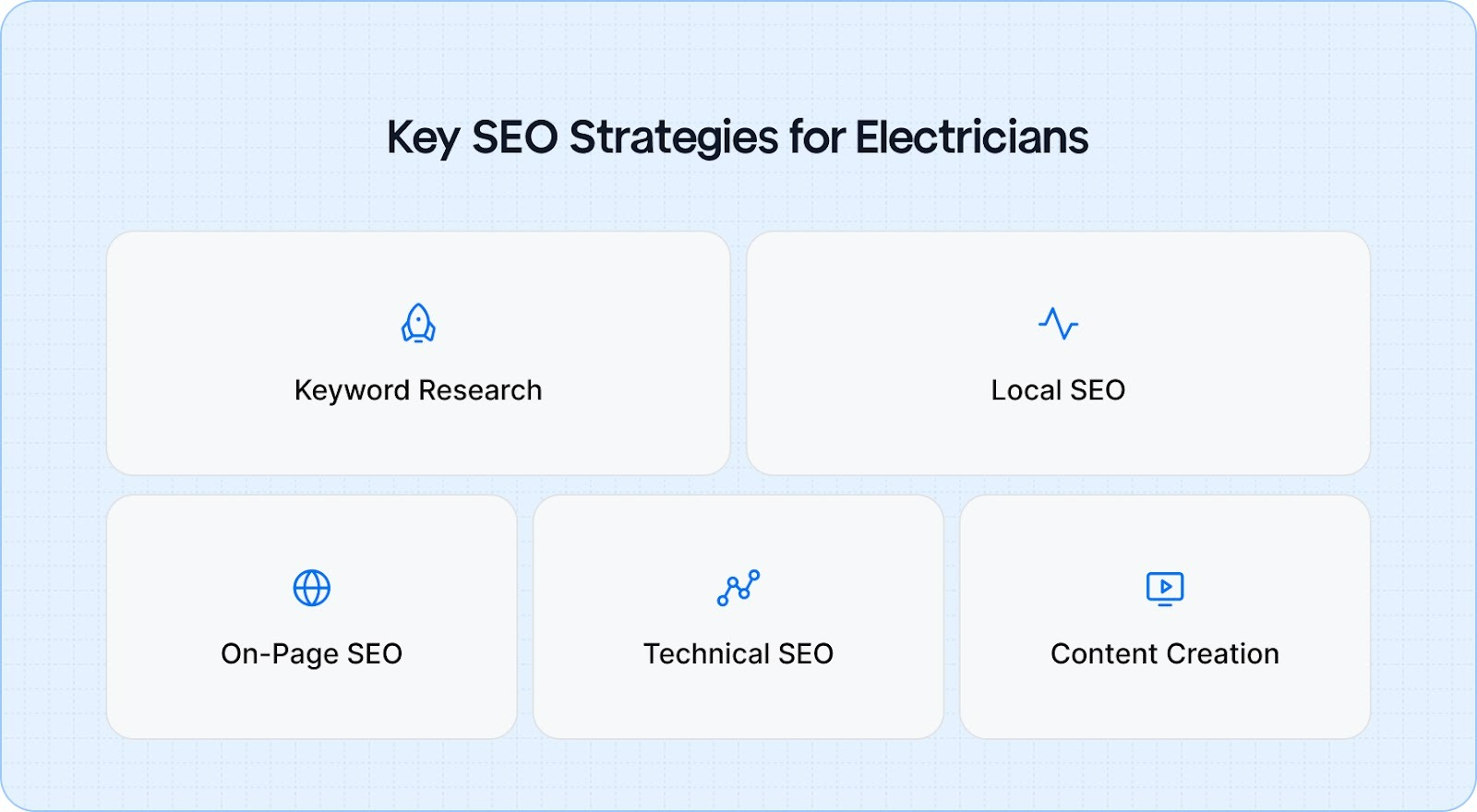
When you’re running an electrical business, the last thing you want is for potential customers to overlook your expertise simply because they couldn’t find you online.
The right SEO strategies can help you change that, making sure your business stands out when customers are searching for electrical services.
Before your customers can find you, they need to know what to search for. Keyword research is all about identifying the terms people are typing into Google when they need your services.
By targeting high-traffic keywords like “electrical panel installation” or “reliable electrician in [city],” you ensure that your website ranks for the terms most likely to bring in the right kind of leads.
Your community is where your business thrives, and Local SEO makes sure that your name is visible to the people who need you most. Here’s how to make the most of it:
Once potential customers find your website, you want them to stick around and convert into leads. On-page SEO is about optimizing each page to ensure it’s both user-friendly and search engine-friendly. Here’s what you need to focus on:
The technical side of SEO ensures your website is built to support both search engines and visitors. Technical SEO focuses on making sure your site works smoothly under the hood. Here’s what to keep in mind:
Content is a great way to show potential customers that you’re an expert in your field. By creating helpful, informative content, you can improve your SEO while building trust with your audience. Here’s how:
Establishing your business as a trusted local expert goes beyond your website. By earning quality backlinks and managing your online reputation, you can significantly increase your visibility and credibility.
You’ve probably heard that backlinks are one of the most powerful ways to improve your site’s authority. But what does that really mean for you as an electrician? In simple terms, backlinks are like "votes of confidence" from other websites that tell search engines your business is credible.
The more quality sites link to your page, the higher you rank. Start by earning backlinks from local directories, industry-related blogs, or even suppliers you work with. These links improve your SEO and help you build trust with both search engines and customers.
Your online reputation is one of your strongest assets. Customer reviews are a key part of that. A good review can make a potential client choose you over the competition. Actively managing reviews means responding to both positive and negative feedback, showing customers that you care about their experience.
Encouraging satisfied clients to leave positive reviews on platforms like Google, Yelp, or Facebook can significantly increase your local SEO rankings and establish your business as a trusted provider in the area.
In a relevant Reddit thread, many electricians and local service providers discuss how simple local SEO practices, like optimizing your GBP and collecting reviews, can help drive real results.

This kind of reputation management is crucial for improving your SEO standing and gaining visibility when potential customers are looking for your services.
When potential customers search for an electrician in your area, you want your business to be one of the first they see.

The Local Pack is where your business can shine, but getting there requires a few key steps:
The more complete and accurate your profile, the more likely it is to show up when someone searches for local services.
This simple step tells Google that your business is trustworthy and helps you rank higher in local searches.
When Google sees active reviews, it increases your credibility and helps you rank higher in search results.
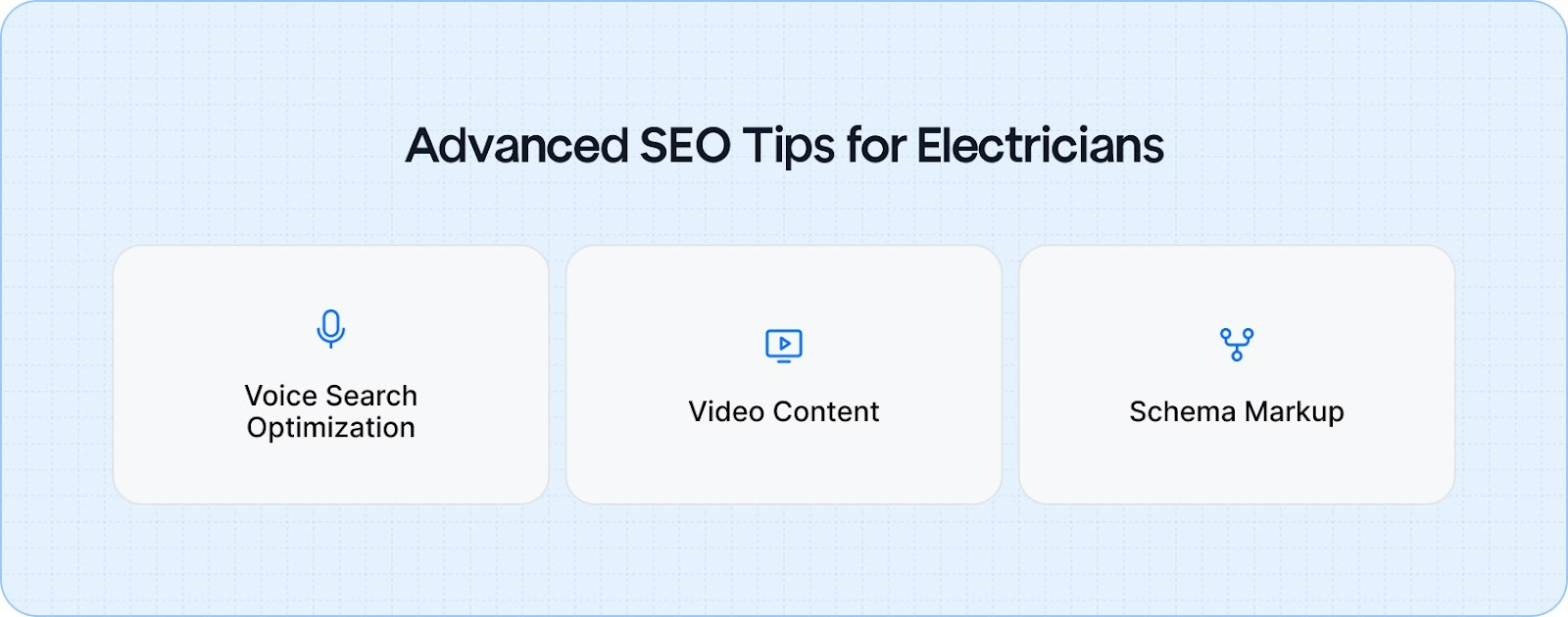
Now that you’ve mastered the basics, it’s time to elevate your SEO strategy with more advanced techniques.
By fine-tuning these elements, you’ll ensure your business is found more easily and engages potential customers more effectively.
Use natural, conversational phrases in your content, like “Best electrician in [city] for home repairs”, to match how customers ask questions.
Google loves video content, and when you post engaging videos on your website or YouTube, you create valuable touchpoints for future clients.
By adding structured data to your website, you increase the chances of appearing in featured snippets, local searches, and other specialized results.
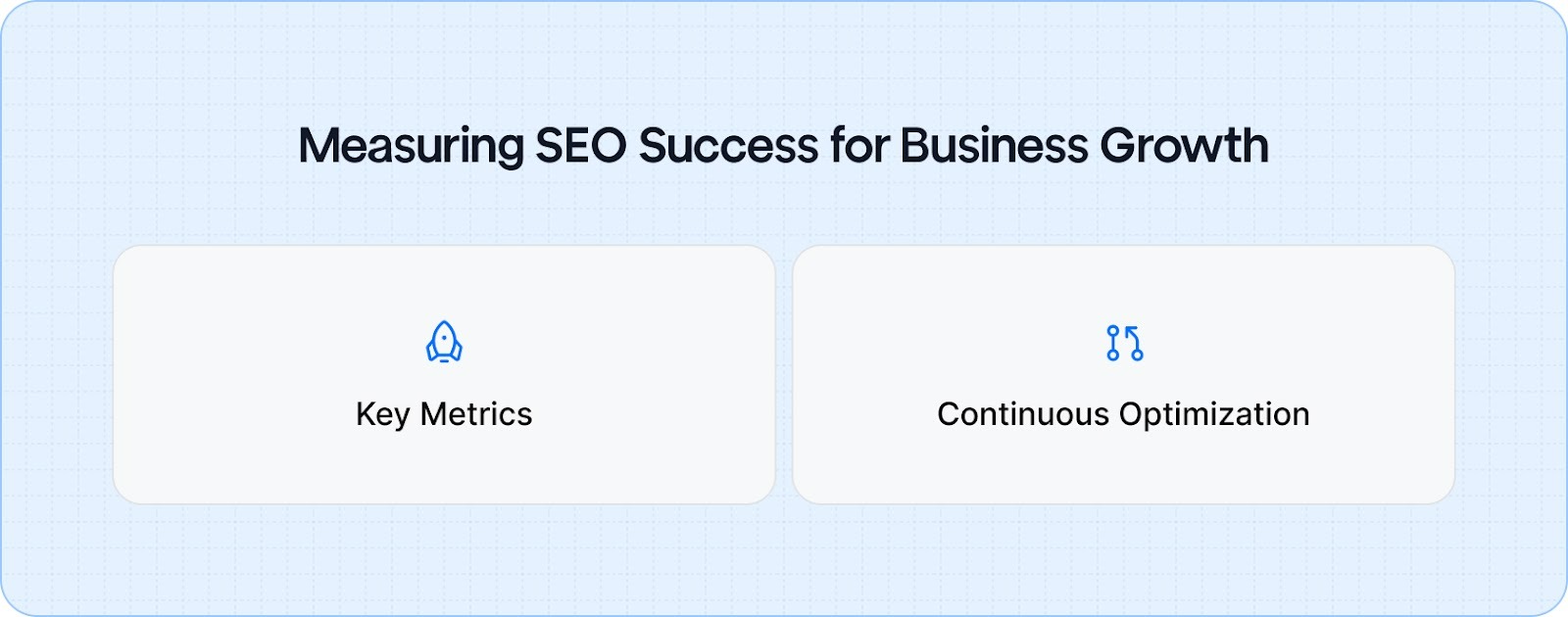
Once you've put the work into optimizing your website, it's crucial to track how well it's performing. Measuring SEO success is about understanding how your efforts are translating into real results. Here’s what to look for:
Are more people finding your website through Google? Are they sticking around to book your services? These metrics tell you exactly that.
By refining your approach over time, you’ll ensure that your business continues to grow and attract more local customers.
Local SEO, great content, and managing your online reputation are the keys to making sure your business stands out when customers need you most.
These strategies are about building trust, engaging with your community, and becoming the go-to electrician in your area.
A1: The most important SEO strategies for electricians include local SEO optimization, keyword research, and reputation management. Start by optimizing your Google Business Profile, use location-specific keywords in your content, and encourage customer reviews. Additionally, ensure your website is mobile-friendly and fast to load.
A2: To optimize your Google Business Profile (GBP), ensure all your business details are accurate and up-to-date, including your name, address, phone number (NAP), and service areas. Add high-quality photos, write a compelling business description, and regularly post updates and promotions to stay active and visible in local searches.
A3: Local SEO focuses on optimizing your website and online presence so that you appear in search results for customers near you. It includes tactics like optimizing your GBP, using local keywords (e.g., "electrician in [city]"), and ensuring your name, address, and phone number are consistent across directories and platforms.
A4: SEO is a long-term strategy, and it usually takes 3 to 6 months to see significant results. The time it takes depends on various factors, such as the competitiveness of your market, the quality of your content, and how well your website is optimized for search engines.
A5: Encourage satisfied customers to leave reviews by making it easy for them. Send follow-up emails or texts asking for feedback after completing a job, and provide direct links to your review platforms. Responding to all reviews, both positive and negative, shows you value customer input and can improve your reputation.
A6: Tools like Google Analytics, Google Search Console, and SEMrush are excellent for tracking SEO performance. These tools allow you to monitor traffic, keyword rankings, and customer engagement, helping you adjust your strategy for better results over time.
A7: To improve your website’s ranking, focus on optimizing your content with relevant keywords, ensuring your website is mobile-friendly and fast, and building high-quality backlinks. Regularly update your site with helpful blog posts and FAQs that answer customer questions and enhance your website’s authority.
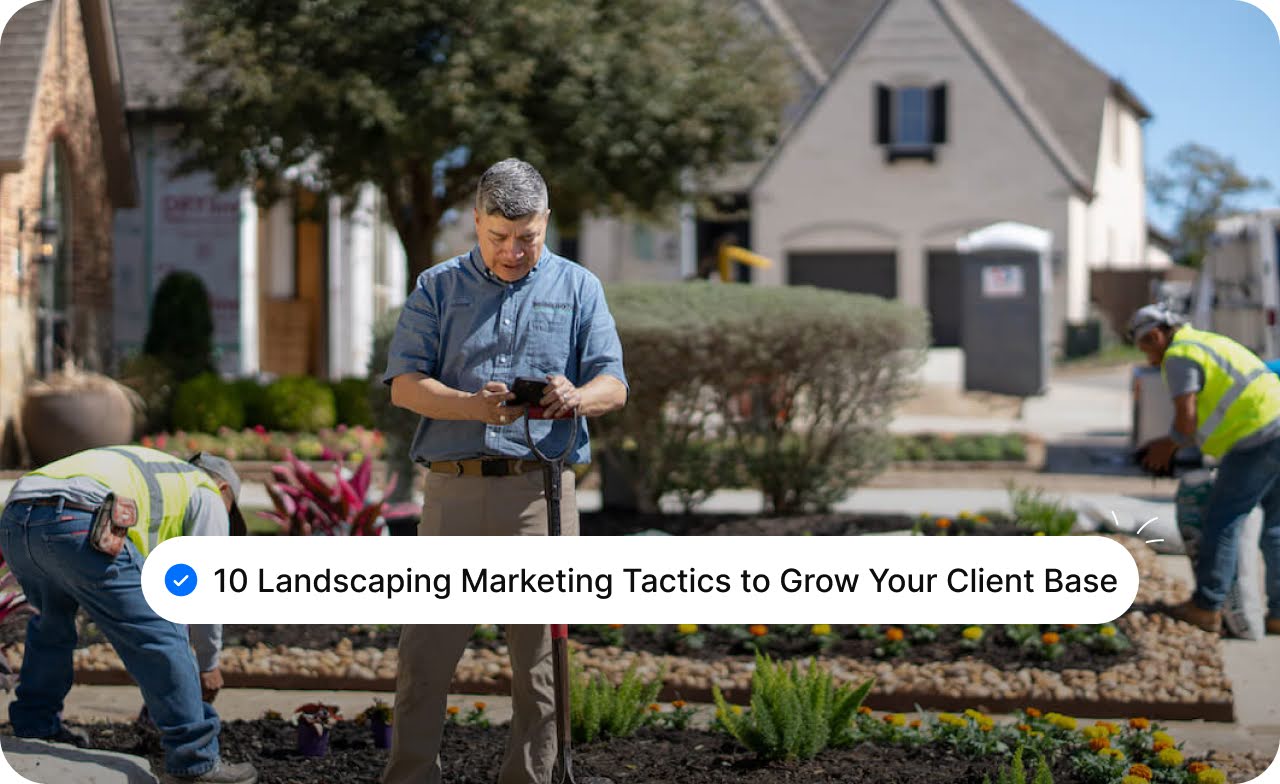
Creating beautiful outdoor spaces is an accomplishment, but getting the right clients to notice your work is where many businesses struggle.
Despite the quality of your projects, attracting consistent, high-value leads can feel like a never-ending challenge. In an industry where competition is fierce, relying solely on word of mouth isn’t enough to drive growth.
This guide will equip you with proven landscaping marketing strategies that will help your business stand out, attract high-value clients, and drive long-term success, starting today.
Quality work alone won’t drive your business forward if you’re not reaching the people who value your expertise.
The key to success lies in identifying who your ideal clients are and personalizing your marketing efforts to speak directly to them.
Actionable Strategy:
Example: If you’re skilled in high-end landscape design, target affluent neighborhoods where homeowners are more likely to invest in custom features like outdoor kitchens or water features.
Your brand should clearly communicate who you are, what you offer, and why your business is the best choice for your clients. When your brand resonates with potential clients, it builds trust and helps you attract the right audience.
Actionable Strategy:
Your website is your digital storefront. If it’s difficult to navigate or doesn’t effectively communicate the services you provide, visitors will quickly move on.
A website that clearly presents your offerings and makes it easy for clients to reach you can convert casual visitors into paying customers.
Actionable Strategy:

Being visible when potential clients search for landscaping services nearby is essential.

Local SEO ensures that your business appears at the top of search results when people in your area are actively looking for the services you offer.
Actionable Strategy:

Social media is a powerful marketing tool that can help you build relationships and trust with potential clients.

When used effectively, social media can elevate your brand and encourage people to choose you for their landscaping needs.
Actionable Strategy:

Google Ads allow you to target people actively searching for landscaping services in your area. By targeting high-intent keywords, you can quickly connect with clients who are ready to take action.
Actionable Strategy:

You've generated interest, but how do you keep your business top-of-mind until they’re ready to book? That's where email marketing comes in, helping you stay in touch with potential and existing clients and turning leads into long-term customers.
Actionable Strategy:

There's no better endorsement for your landscaping business than a satisfied customer telling their friends and family about your services.

Referral marketing taps into the trust people place in personal recommendations, helping you grow your client base with minimal effort.
Actionable Strategy:

Networking is an opportunity to create strategic partnerships that help grow your business. By collaborating with complementary local businesses, you can tap into new client bases and build mutually beneficial relationships that go beyond one-time sales.
Actionable Strategy:

To see real growth, you need to analyze how well your marketing strategies are performing.
Tracking key metrics will help you understand what’s driving leads and conversions, so you can continually improve your approach.
Actionable Strategy:

You have seen how implementing these 10 proven landscaping marketing strategies can make all the difference.
From defining your ideal client to optimizing your website and using local SEO to your advantage, each tactic has the power to help you attract the right leads, build lasting relationships, and ultimately grow your business.
Marketing doesn’t have to be overwhelming. With the right strategies in place, you can see consistent results, from gaining more clients and increasing your revenue to building your brand’s reputation.
A1. The best landscaping marketing strategies include a combination of local SEO, social media engagement, Google Ads, and email marketing. It's essential to identify your target audience and use clear, high-quality visuals of your work to capture their attention. Additionally, creating a user-friendly website with an easy way for clients to request quotes is crucial for generating leads.
A2. Attracting more landscaping clients starts with a strong online presence. Optimize your website for local SEO, run targeted ads on social media and Google, and engage with clients on platforms like Instagram and Facebook. Word-of-mouth referrals are also powerful, so encourage satisfied customers to leave reviews and share their experiences.
A3. The best way to advertise landscaping services is through a mix of online and offline methods. Invest in Google Ads and local SEO to appear in search results when potential clients look for landscaping services nearby. You can also use social media platforms to showcase your work, engage with your audience, and promote special offers. Offline methods like direct mail and sponsoring community events also help increase visibility.
A4. Targeting customers for landscaping requires a deep understanding of your ideal client. Define buyer personas based on factors such as location, income level, and the types of services they need. Use local SEO to make your business visible to nearby clients and run targeted ads to reach specific demographics. Networking with local businesses and asking for referrals can also help you attract the right customers.
A5. Local SEO for landscaping involves optimizing your online presence to rank higher in search results for location-based keywords like "landscaping near me" or "lawn care in [your city]." This includes claiming and optimizing your Google Business Profile, adding your business to local directories, and ensuring your website includes keywords specific to the areas you serve. Positive customer reviews and local backlinks are also important for improving local SEO.
A6. To generate leads for your landscaping business, focus on creating a strong online presence. This includes optimizing your website for SEO, using social media platforms to engage with potential clients, and running targeted Google Ads. Offering promotions, creating informative blog content, and using email marketing to stay in touch with prospects can also help convert interest into leads.
A7. Some of the best marketing tools for landscapers include Google Ads for targeted advertising, social media platforms like Instagram and Facebook for showcasing work, and local SEO tools like Moz or Yoast to optimize your website. For managing leads and customer interactions, tools like HubSpot or Jobber can help automate processes and track marketing performance. Email marketing platforms like Mailchimp are also useful for nurturing leads.
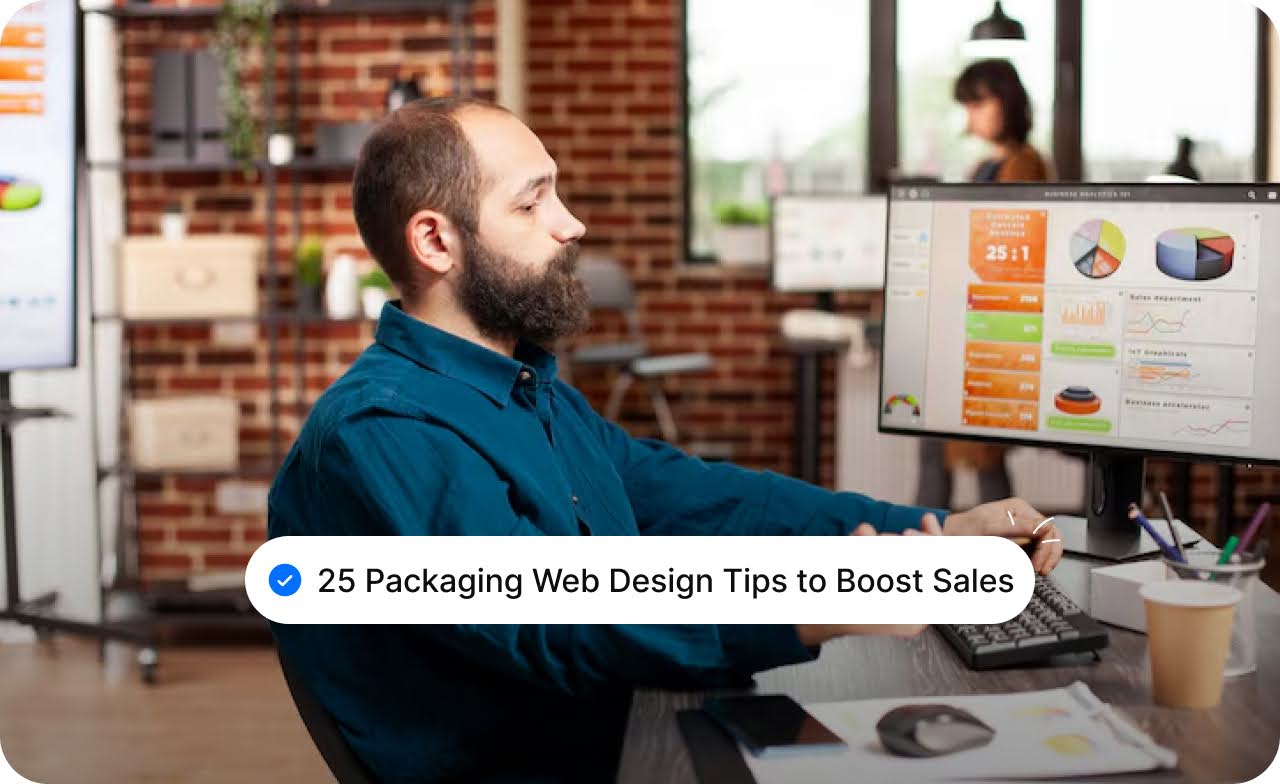
Your packaging website is your first chance to impress potential clients. But many websites fail to capture attention. They’re either cluttered or don’t showcase the creativity behind your designs.
When clients land on your site, it should spark excitement and drive action. Your website needs to create an experience that encourages visitors to engage with your work and take the next step.
This guide will explore 25 expert tips to help you craft a website that not only looks great but converts visitors into clients. Ready to elevate your online presence? Let’s dive in!
Your homepage is the first chance you get to make a strong impression.

Visitors should instantly feel your creativity and expertise the moment they land on your page.
Your homepage is the starting point of your story; it’s where visitors first meet you. When done right, it’s a conversation that gets them interested in what’s to come.
Visitors arrive with curiosity, but without the right guidance, they’ll be unsure what to do next. That’s where CTAs come in.
A well-placed CTA shows visitors how to take the next step in working with you.
Great web design is focused on functionality. If visitors can’t find what they need quickly, they’ll leave.
When a visitor lands on your site, they should feel like they’re walking down a clear path, knowing exactly where to go and how to get there.
With more than half of all web traffic coming from mobile devices, your website needs to work seamlessly on smartphones and tablets.

Mobile-first design is about making sure your visitors can access your content whenever and wherever they need to.
A stagnant website can make your brand seem outdated. Keep your content fresh to show you’re active and engaged.
A website that feels fresh and current shows visitors that your brand is alive, active, and ready to innovate.
A slow website can make visitors lose interest before they even see your work.
Even seconds matter. A fast-loading website will keep visitors engaged and on your site longer, increasing the chance they’ll explore your work further.
Your portfolio is the heart of your website. This is where potential clients see the best of your work, but it’s also your opportunity to tell the story behind each design.
A portfolio should narrate your design journey and the impact it made.
Nothing makes a design feel real like seeing it in action.
This is where your packaging truly comes to life, and visitors can experience it in a way that feels real and tangible.
Engagement is about making visitors feel like they’re part of your creative process.
The more interactive your website is, the more engaged your visitors will feel, making them more likely to inquire about your services.
Packaging is about the story behind it.

When you tell a story, your packaging becomes a part of a bigger narrative that visitors can connect with.
Sustainability is now a requirement. More consumers are looking for brands that care about the environment.
Clients today want packaging that also aligns with their values. Make sustainability a core part of your brand message.
Brand consistency builds trust. Your website should reflect your brand’s unique personality, from fonts to imagery. Visitors should instantly recognize your brand's style and feel confident that your packaging designs align with your identity.
When your branding is consistent, it creates a professional and trustworthy image that visitors can connect with.
Great design refers to how things work. User experience (UX) should be at the core of your website's design.
By prioritizing UX, you create a site where visitors feel comfortable and guided, leading them naturally to the next step in their journey with your brand.
Real feedback from satisfied clients provides social proof. A well-placed testimonial can turn a curious visitor into a loyal client.
Visitors are more likely to trust you when they see positive experiences from others.
Video is a powerful tool for engaging your audience. A short video showcasing your design process or a time-lapse of packaging coming to life can captivate visitors in a way static images cannot.
A video adds a dynamic element to your website and keeps visitors hooked longer.
A large portfolio is great, but it’s important that visitors can find what they’re looking for quickly.
By allowing users to filter through your work, you make the experience personalized and efficient.
Your packaging designs deserve to be shown in the best light. Low-quality images can give the wrong impression.
High-quality imagery makes your packaging designs look polished and professional, boosting their appeal to potential clients.
When visitors are ready to take the next step, you don’t want them scrambling to find your contact details.
Visitors should never feel frustrated trying to reach out to you. Making it easy increases the likelihood of conversions.
Social media is a powerful tool for growing your brand. Display your social media feeds or links on your website to show potential clients where they can connect with you.
By integrating social media, you add credibility and make your website feel more connected to your audience.
Subtle animation can bring your website to life without overwhelming your visitors.
Animations add a layer of interactivity that can make the browsing experience more enjoyable and engaging.
An “About Us” page is more than just a brief company history; it’s where you can connect on a personal level with potential clients.
A compelling About Us page builds rapport and trust, making it easier for visitors to feel comfortable with your services.
While some packaging designers prefer not to list prices upfront, providing a price range can help manage client expectations.
Clear pricing information reduces friction and helps visitors decide if they’re ready to work with you.
Anticipate common client questions and answer them upfront to save time for both you and potential clients.
A well-organized FAQ section answers questions before they become barriers to conversion.
Security is crucial for building trust with your visitors. Make sure your website is secure and visibly so.
A secure website not only protects you and your clients but also instills trust in visitors.
Creating a seamless and clear client onboarding experience can make all the difference in how your potential clients perceive your service. A simple, well-structured onboarding process builds trust and sets expectations right from the start.
By making onboarding clear and simple, you’ll make clients feel confident in choosing you, helping to turn them into long-term partners.
A website showcases your work, draws people in and keeps them coming back. By following these 25 expert packaging web design tips, you will be creating a digital portfolio and building a powerful tool that engages, inspires, and converts visitors into loyal clients.
From the design layout to seamless functionality, every choice you make should reflect your unique brand and make a lasting impression.
It’s important to have a site that works for you, attracting the right clients and driving real business growth.
So, why settle for ordinary when your website can be extraordinary?
A1. Packaging design is more than just a protective layer; it's the first impression your product makes on a potential customer. A well-designed package can communicate your brand's story, values, and quality, influencing purchasing decisions and setting your product apart in a crowded market.
A2. Selecting the right materials involves balancing functionality, cost, and brand image. Consider factors like product fragility, shelf life, and environmental impact. For instance, eco-friendly materials might appeal to environmentally conscious consumers, while premium finishes can enhance the perceived value of luxury items.
A3. Consistency in packaging design helps build brand recognition and trust. While variations can exist to distinguish different products, maintaining core elements like logo placement, color scheme, and typography ensures a cohesive brand identity across your product line.
A4. To capture attention, focus on unique design elements that reflect your brand's personality. Bold colors, innovative shapes, and interactive features can make your packaging eye-catching. Additionally, clear messaging and storytelling can create an emotional connection with consumers.
A5. In e-commerce, packaging serves as both a protective barrier during shipping and a branding tool upon delivery. Thoughtful packaging can enhance the unboxing experience, leading to positive reviews and repeat customers. It's an opportunity to reinforce your brand's commitment to quality and customer satisfaction.
A6. Compliance with industry regulations is crucial to avoid legal issues. Research and understand the specific requirements for your product category, such as labeling laws, safety standards, and environmental guidelines. Consulting with experts or legal advisors can help navigate these complexities.
A7. Embracing sustainable packaging can resonate with eco-conscious consumers and enhance your brand's reputation. Using recyclable or biodegradable materials, minimizing waste, and communicating your sustainability efforts transparently can build consumer trust and loyalty.

You’ve probably noticed it yourself; one quarter, your inbox is packed with leads; the next, it’s silent. The issue isn’t your product quality or delivery timelines. It’s visibility. Your next buyer can’t find you.
In manufacturing, where purchase cycles are long and each order represents a major investment, relying on referrals or the occasional trade show no longer guarantees steady growth.

Many manufacturers attract plenty of website visitors but very few genuine prospects. Most leave before submitting a quote request because the outreach brings in browsers, not buyers.
This guide on 10 ways to generate leads for your manufacturing business shares proven strategies for manufacturers, machine shops, fabricators, and equipment suppliers seeking steady, qualified leads from buyers who value precision and reliability.
Every successful sales effort begins with clarity. Before investing in ads or social media, define exactly who you want to attract.
A lead is a potential buyer who has shown genuine interest, maybe they downloaded a catalog or filled out a lead form. It’s not every visitor who lands on your site, but the ones with real purchase intent.
Too often, manufacturers chase “anyone who needs fabrication” and waste time on non-buyers, such as students or hobbyists. Defining your Ideal Customer Profile (ICP) prevents that confusion.
Your ICP includes:
Example: A CNC tooling supplier focusing on aerospace manufacturers might target plant managers who struggle with late deliveries from existing vendors.
Your website shouldn’t be a digital catalog, it should be your best salesperson working 24/7.
Traffic refers to the number of people visiting your site. But qualified traffic means visitors who genuinely need what you sell. The goal is to have better visitors who can convert into leads.
Your homepage is like your showroom. If it’s cluttered, unclear, or hard to navigate, visitors will leave without asking a single question.
To turn visitors into inquiries, include:

Your buyers are looking for solutions. SEO (Search Engine Optimization) helps them find you when they search online. It’s the process of making your website and blogs appear when buyers Google things like “custom precision machining supplier USA.”

Your content is your sales pitch that runs even when you’re offline. The right topics attract serious decision-makers:

LinkedIn has become the online version of a trade floor for manufacturers, but it works only when you engage, not when you broadcast.
A small machining company once started sharing real stories about production challenges solved on the shop floor. Within weeks, plant heads and buyers began messaging directly for quotes.
To make LinkedIn work for you:

PPC (Pay-Per-Click) advertising means you pay only when someone clicks your ad, not for empty views. It’s one of the fastest ways to reach buyers already searching for your product.
Think of it as placing a spotlight above your brand when a potential buyer types “ISO-certified injection molding company.”
Start small and focus on:
Must Read: Top 5 Lead Generation Companies for Manufacturers to Boost Your Sales

Not every lead is ready to buy immediately. Email nurturing helps you stay top-of-mind until they are.
Email marketing is simply sending helpful, relevant updates to potential buyers over time. It builds familiarity and credibility without constant selling.
A fabrication firm that sent short monthly updates, like project photos, design tips, and new certifications, saw past prospects return with fresh leads.
Automation tools can help you:
Buyers trust what they can see. Webinars and demos give them that confidence before they even visit your facility.
A metal finishing company once hosted a 30-minute online demo showing its testing and coating process. The result? 80 qualified leads in one week.
Ideas that work:

Trade shows build relationships, but most companies lose momentum afterwards.
A sheet-metal manufacturer used QR codes at its booth to collect visitor data, synced it to their CRM, and sent personalized follow-ups within 24 hours. The outcome: conversions doubled.
To make the most of events:

In manufacturing, your best new customer often comes from someone who already trusts you.
A parts supplier once partnered with a logistics company. They cross-referred clients, creating a steady pipeline without extra marketing cost.
Try this:

You can’t improve what you don’t measure. Analytics show where your leads come from and which channels deliver real results.
A manufacturer noticed that LinkedIn traffic converted twice as well as Google Ads clicks. After shifting its budget, it doubled leads in six months.
Track these key metrics:

You already know what precision means; it’s what keeps your machines running, your deliveries on time, and your customers coming back. But growth doesn’t happen by chance; it happens by process.
The manufacturers thriving today aren’t relying on luck or referrals; they’ve built systems that attract and convert qualified buyers like clockwork.
Your production line is optimized to deliver consistent output. Your marketing should work the same way: predictable, measurable, and built to run smoothly without constant supervision.
If you are ready to create a marketing system that works as efficiently as your factory floor, Gushwork can help.
A1: Start by optimizing your LinkedIn profile and engaging in industry-specific groups. Utilize advanced search filters to identify decision-makers in your target industries. Share valuable content, such as case studies or technical insights, to establish credibility and attract potential leads. Additionally, consider attending virtual trade shows or webinars to network with prospects.
A2: Focus on digital marketing tactics like search engine optimization (SEO) to improve your website's visibility. Create content that addresses common industry challenges and showcases your expertise. Leverage social media platforms to engage with your audience and participate in relevant discussions. Implementing a customer relationship management (CRM) system can also help streamline follow-ups and manage leads efficiently.
A3: Develop buyer personas by analyzing your existing customer base and identifying common characteristics such as industry, company size, and purchasing behavior. Utilize tools like LinkedIn's advanced search to find prospects that match these profiles. Engage with industry-specific forums and groups to gain insights into potential customers' needs and challenges.
A4: Yes, when done correctly. Craft personalized emails that address the specific needs and pain points of your target audience. Avoid generic templates; instead, focus on how your product or service can provide value. Tools like Apollo and Saleshandy can assist in automating and tracking your outreach efforts.
A5: Ensure your website is user-friendly and optimized for search engines. Include clear calls-to-action, such as request forms or contact information, to encourage visitor engagement. Showcase testimonials, case studies, and detailed product information to build trust with potential leads.
A6: Trade shows offer opportunities to showcase your products and network with potential clients. Collect contact information from visitors and follow up promptly after the event. Integrating digital tools, like QR codes, can streamline the process of capturing leads and enhance post-event engagement.
A7: Track key performance indicators (KPIs) such as website traffic, conversion rates, and the number of qualified leads generated. Utilize analytics tools to assess the performance of different marketing channels and adjust your strategies accordingly. Regularly reviewing these metrics can help optimize your lead generation process.
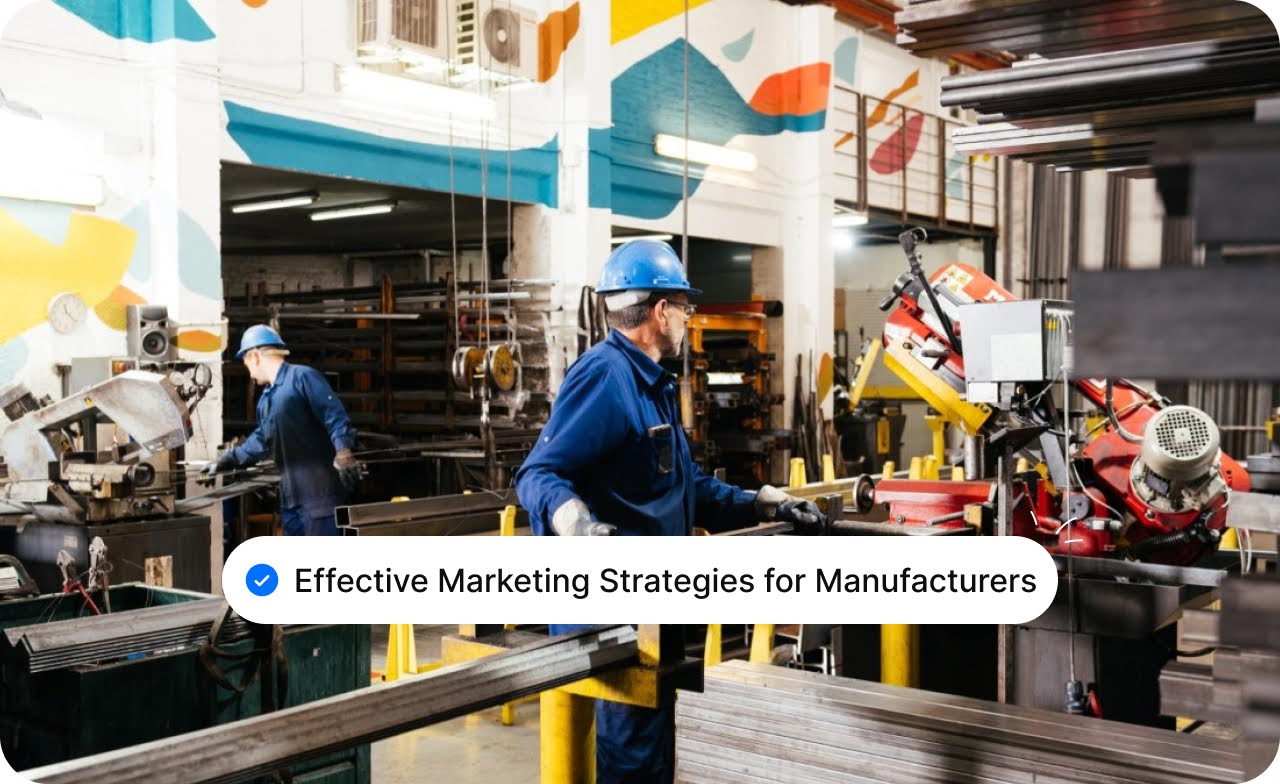
The real frustration? Pouring ad spend into strategies that fail to filter out the noise, leaving your sales team to sift through inquiries that never stand a chance of converting.

This guide dives deep into manufacturer marketing strategies designed to target the precise audience that matters, decision-makers who know exactly what you offer and why it’s essential to their business.
In the manufacturing industry, marketing is about building long-term relationships with the right buyers.
In B2B manufacturing, marketing helps create a clear brand presence, establish credibility, and generate quality leads. A well-structured marketing strategy ensures that your products reach the right people at the right time, helping your business stand out in a competitive market.
Without it, you risk becoming just another name in a crowded industry, struggling to get noticed.
Manufacturers often face unique challenges when it comes to marketing. Here are a few of the biggest hurdles:
A striking example comes from a Reddit discussion where a manufacturer revealed that despite generating millions in sales, they had invested almost nothing in marketing.
This lack of visibility led to the loss of several high-value accounts simply because potential clients were unaware of their existence.
A winning marketing strategy directly impacts your bottom line in several ways:

A solid marketing strategy is essential for growth and attracting the right customers in the manufacturing industry.
Here’s a simple roadmap to create a plan that engages decision-makers and generates high-quality leads.
Start by defining SMART goals:
This ensures your marketing efforts are focused and measurable.
Know your target audience:
Watch this video to learn more about crafting your marketing strategy and building strong customer profiles that resonate with the right audience.
(Embed the video here)
Create content that connects with your audience:
Content builds trust and keeps your audience engaged.
Together, they increase your online presence and attract quality traffic.
Use platforms like LinkedIn to connect with decision-makers:
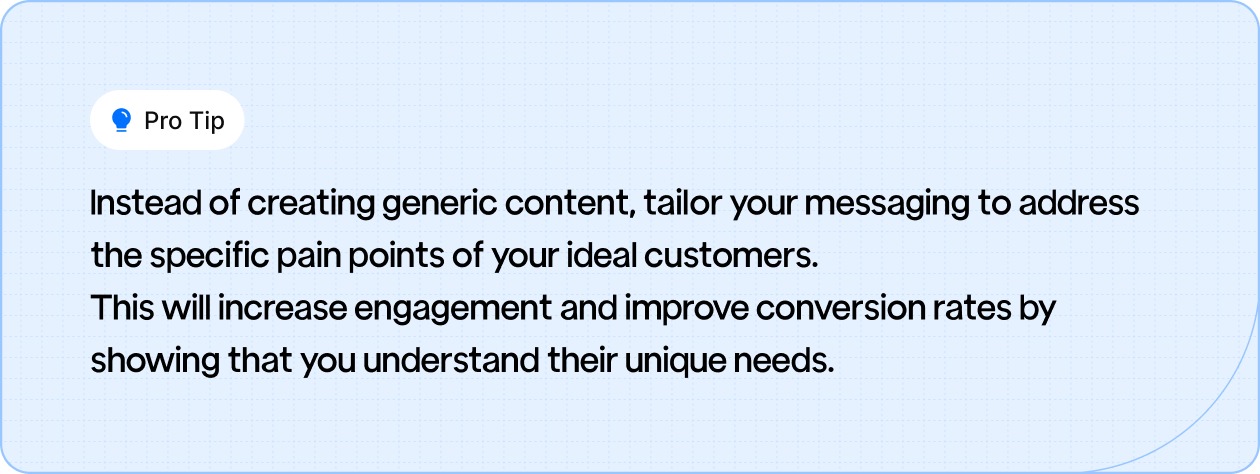
Manufacturers need to stay ahead by mastering the latest marketing tactics that drive engagement and lead generation.
These strategies will help you reach the right audience and increase your brand’s impact in the market.
Manufacturers must focus on creating technical, value-driven content that speaks directly to their audience’s needs.
This approach positions your brand as a trusted resource and drives higher engagement with a targeted audience.
Trade shows, both in-person and virtual, offer invaluable opportunities to connect directly with your audience.
Use these events to engage prospects and nurture relationships that may convert into long-term partnerships.
Collaborating with industry influencers or partnering with other manufacturers can significantly expand your reach.
These partnerships can help increase brand visibility and credibility within your industry.
Email marketing remains one of the most effective channels for B2B manufacturers.
By automating your email outreach, you can build stronger relationships with prospects, making them more likely to convert.
Focusing your marketing efforts on high-value target accounts allows you to create personalized campaigns for the businesses most likely to purchase.
This targeted approach maximizes the impact of your marketing budget, increasing conversion rates and driving revenue.
Must Read: Digital Marketing for Distributors: 10 Proven Strategies for Growth
B2B marketing for manufacturers differs significantly from B2C. Key distinctions include:
Niche Markets: Manufacturing often targets specialized industries, requiring tailored marketing approaches.
To maximize the impact of your marketing efforts, focus on clear goals, tailored content, and continuous optimization.
Here are the best practices that will ensure your campaigns are effective and aligned with your business objectives.
Create content tailored to each stage of the buyer's journey:
Track key metrics such as conversion rates, traffic, and leads to evaluate your campaign's performance. Tools like Google Analytics help you stay on top of your data.
Marketing isn’t static. Test and optimize campaigns regularly based on performance data to stay responsive to market shifts.

Automation is transforming manufacturing marketing by improving efficiency and personalization.
Here’s how tools like CRM systems and AI-driven insights are helping manufacturers scale their efforts and drive better results.
Marketing automation tools enable manufacturers to streamline processes, scale campaigns, and nurture leads more efficiently.
By automating repetitive tasks like email marketing, social media posting, and lead nurturing, you can focus on strategic decision-making while ensuring consistent engagement across multiple channels.
Integrating marketing efforts with CRM systems allows for better lead tracking and management. It ensures your sales team has real-time data, leading to improved lead conversions and more personalized customer interactions.
Also Read: Why Smart Distributors Are Choosing CRM?
To drive growth and stay relevant in manufacturing, relying on outdated marketing methods or a self-managed approach is insufficient.
Manufacturers need a strategic, automated approach that integrates content, lead generation, and data-driven insights to create lasting impact.
If you’re tired of inefficient marketing processes and missed opportunities, it’s time to invest in the right tools.
A1: Digital marketing for manufacturers involves online strategies like SEO, PPC, content marketing, and social media to attract, engage, and convert potential customers. It allows manufacturers to target specific industries and decision-makers while tracking real-time performance.
A2: To generate quality leads, focus on creating valuable content such as case studies and technical guides, optimizing your website for search engines, and running targeted ads on platforms like Google and LinkedIn. This approach helps attract high-intent prospects who are more likely to convert.
A3: ABM is a strategic approach where marketing efforts are focused on a set of high-value target accounts. For manufacturers, ABM allows for personalized campaigns that address the specific needs of key clients, leading to higher engagement and conversion rates.
A4: Marketing automation tools help manufacturers streamline processes, scale campaigns, and nurture leads more efficiently. By automating repetitive tasks, you can focus on strategic decision-making while ensuring consistent engagement across multiple channels.
A5: SEO helps improve the visibility of your website on search engines, making it easier for potential customers to find your products or services. By optimizing your website's content and structure, you can attract more organic traffic and generate quality leads.
A6: Aligning sales and marketing teams involves setting shared goals, using common tools like CRM systems, and maintaining open communication. This collaboration ensures that both teams work towards the same objectives, leading to improved lead management and higher conversion rates.
A7: Continuous improvement allows manufacturers to adapt to changing market conditions, optimize campaigns based on performance data, and stay competitive. Regularly testing and refining marketing strategies ensures sustained growth and effectiveness.
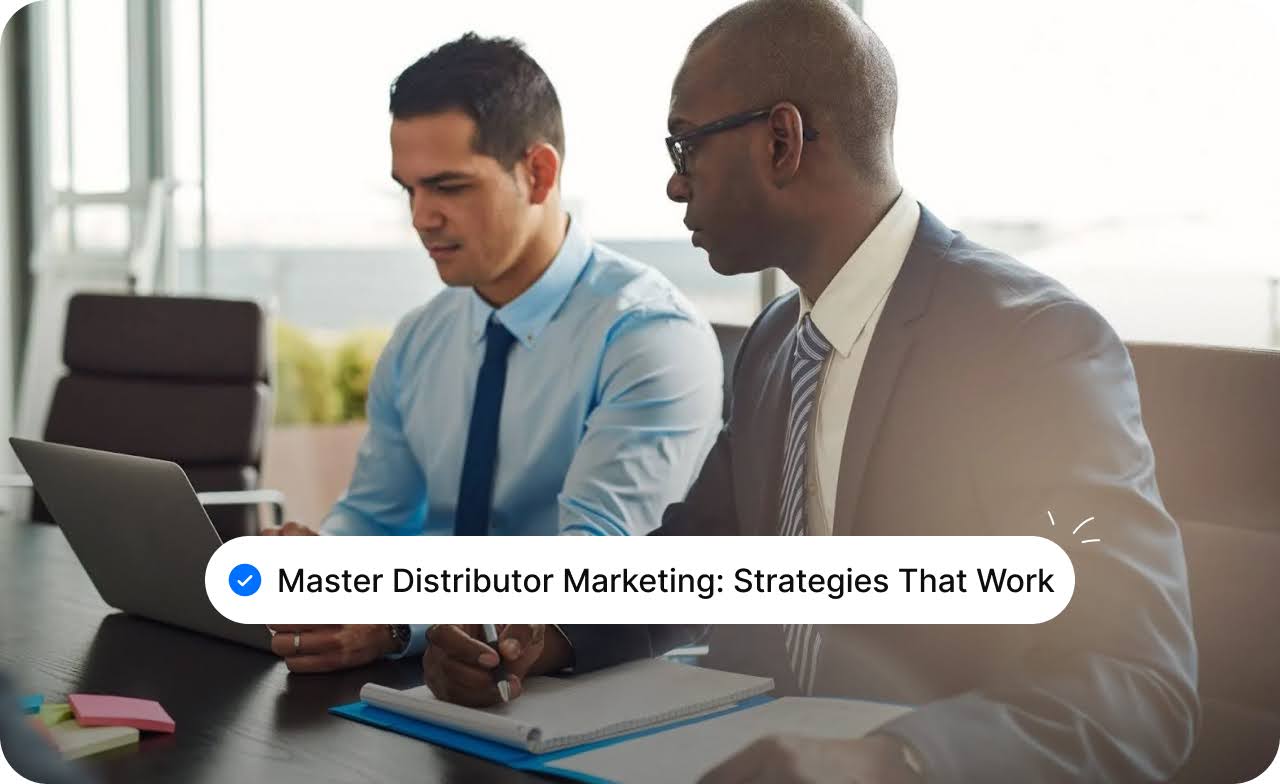
With growing competition from direct-to-consumer brands and eCommerce platforms, it’s becoming harder to stand out in a crowded market. What you need is a distributor marketing strategy that targets the right audience and gets your products in front of the right people.
This guide will show you how to build meaningful relationships with the right resellers and retailers, select the most effective channels, and drive higher-quality sales. If you’re frustrated by ineffective marketing and wasted effort, keep reading for strategies that will help your distribution business excel.
Distributor marketing is simply the process of promoting and selling your products through partners like wholesalers, retailers, or other distributors.
Instead of selling directly to the end customer, you rely on these intermediaries to help get your product to market. It's a crucial part of how your products move from your factory to the final buyer.
This strategy includes creating strong relationships with these partners, building awareness of your brand, and driving sales.

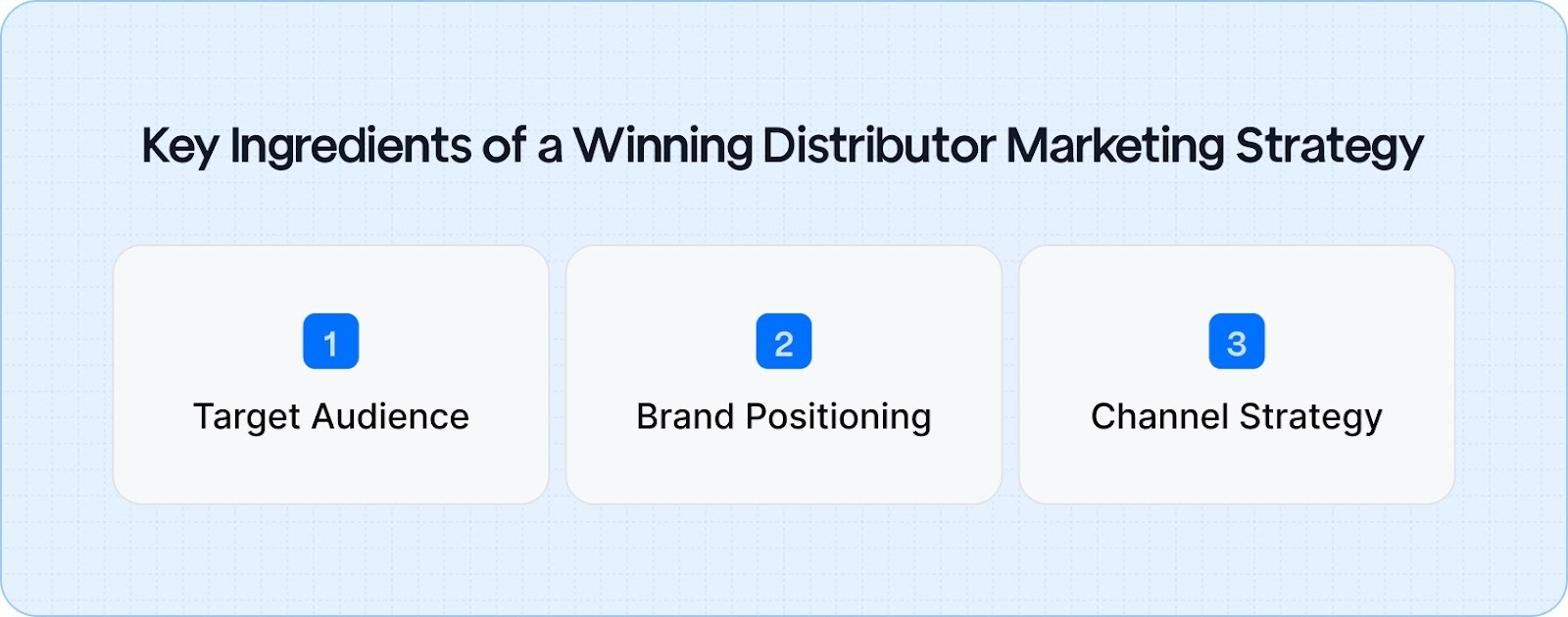
A successful distributor marketing strategy focuses your efforts on the right people, positioning your product in a way that makes it stand out, and choosing the most effective ways to reach them.
Here are the key ingredients that make your strategy work:

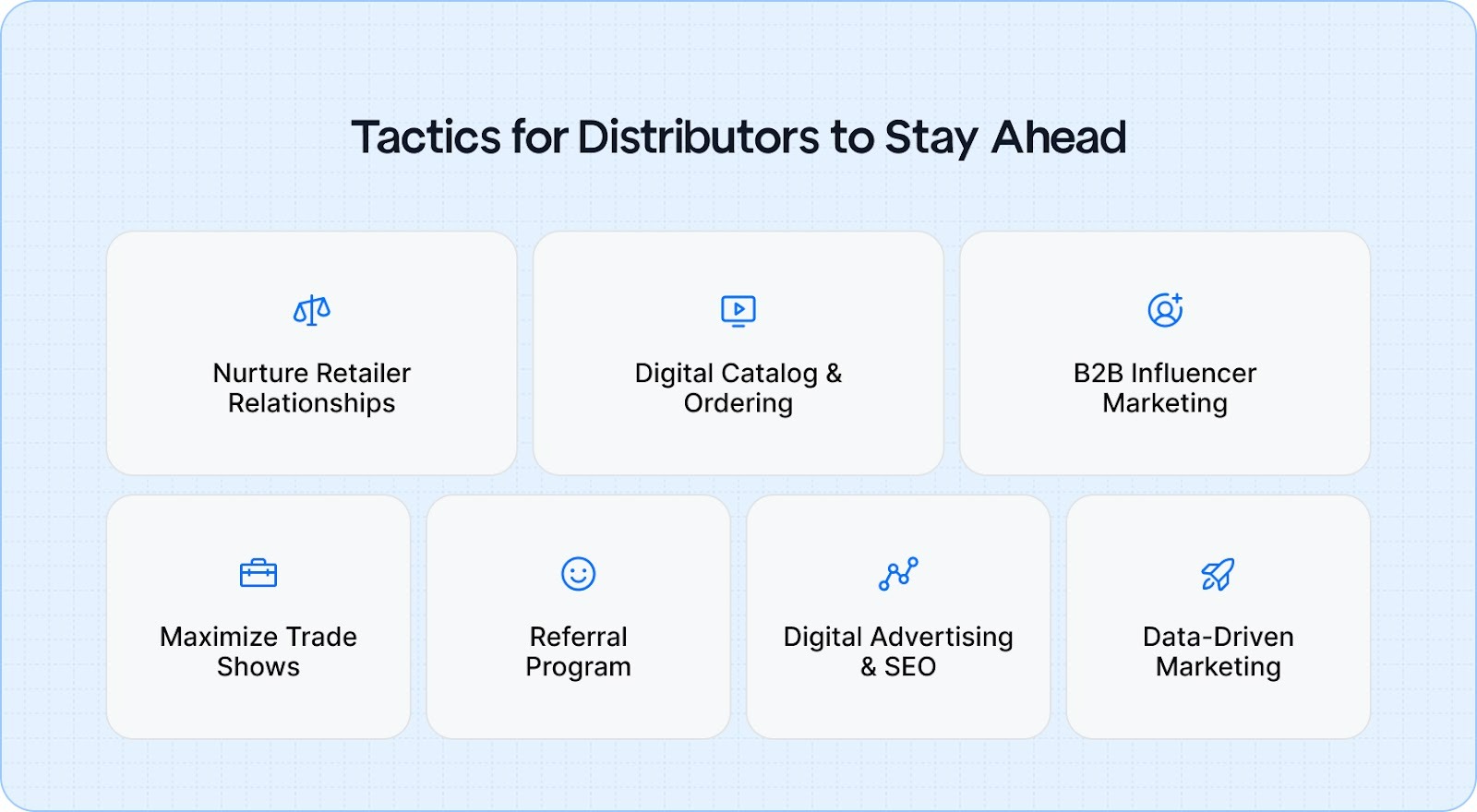
Competing in the distribution industry can feel like a constant race. However, with the right approach, you can stand out from your competitors.
Here are 7 marketing tactics that will help you strengthen your position in the market and gain a competitive edge:
Building strong, long-term relationships with the businesses that sell your products is key. Offer support, tailored incentives, or exclusive deals to ensure they stay engaged with your brand and prioritize your products.
The goal is to make them feel valued and committed to your brand.
Investing in a digital catalog is a game-changer for ease and accessibility. With high-quality images, detailed descriptions, and updated prices, your catalog makes it easier for retailers to view and order products directly from you.
This enhances the buying experience and reduces friction for your resellers.
While influencer marketing is often associated with consumer-facing brands, it's becoming increasingly important in B2B as well.
Partner with industry experts or thought leaders to amplify your message within relevant networks, boosting credibility and broadening your reach.
Trade shows and industry events are perfect for networking and gaining direct feedback from potential customers.
These gatherings allow you to showcase your products in person, build relationships, and identify opportunities for future collaborations, all while staying on top of industry trends.
Referral programs are one of the most effective ways to gain new business. Reward existing customers for referring others, using discounts, exclusive products, or added services.
It’s a cost-effective way to build trust and extend your network organically.
Digital advertising and SEO go hand-in-hand in helping your brand stand out in search results. Optimizing your website for relevant keywords and investing in targeted digital ads ensures that potential customers can easily find your products when searching for solutions you offer.
Data-driven marketing is all about understanding your customers’ behaviors. By analyzing purchasing patterns and customer interactions, you can create tailored marketing campaigns that directly address their needs, making your outreach more effective and valuable.
Understanding the differences between B2B (business-to-business) and B2C (business-to-consumer) marketing is crucial for distributors looking to refine their marketing strategies.
While both approaches aim to sell products, the methods and focus areas differ greatly.
In B2B, your customers are other businesses. This means your sales cycle is typically longer, and the decisions made are based on logic, efficiency, and cost-effectiveness.
In this context, your marketing efforts should focus on:

In B2C, you’re marketing directly to the end consumer. The sales process is typically faster, and emotional appeal plays a larger role in the purchasing decision.
Here, your strategy should include:
A marketing strategy is only as good as the results it delivers. If you don’t measure its impact, how can you know if it’s working?
To ensure your distributor marketing efforts are effective, you need to track the right metrics and use the right tools.
KPIs (Key Performance Indicators) are measurable values that help you evaluate the success of your marketing strategy. Here are some essential KPIs for distributors:
CRM (Customer Relationship Management) software helps you monitor customer interactions, sales data, and marketing campaigns in one place.
These platforms provide insights that help you adjust and optimize your strategy.
Building a solid distributor marketing strategy is key to developing lasting relationships, increasing brand awareness, and driving growth.
Your focus may be B2B or B2C, but having a targeted, thoughtful approach makes all the difference in setting your brand apart in today’s competitive market.
The frustration of ineffective marketing and wasted effort is common, but it's time to shift from ad-hoc tactics to a clear, optimized strategy.
A1. Distributor marketing involves promoting and selling your products through intermediaries such as wholesalers, retailers, or other distributors. It's crucial because it extends your market reach, leverages the distributor's local expertise, and allows you to focus on manufacturing while they handle sales and distribution.
A2. Selecting the right distributor involves assessing their market reach, reputation, and alignment with your brand values. Key factors include their customer base, sales capabilities, and experience in your industry. It's also beneficial to evaluate their financial stability and commitment to marketing your products effectively.
A3. Supporting your distributors with marketing materials like brochures, product samples, and digital content can enhance their sales efforts. Training programs, co-branded campaigns, and access to promotional funds also empower distributors to effectively market your products and increase sales.
A4. Success can be measured using Key Performance Indicators (KPIs) such as sales growth, customer acquisition cost, and customer lifetime value. Tools like Customer Relationship Management (CRM) software can help track these metrics, providing insights into the effectiveness of your marketing strategies.
A5. Omnichannel marketing ensures a seamless customer experience across various platforms. For distributors, this approach can increase brand visibility, improve customer engagement, and drive sales by meeting customers where they prefer to shop.
A6. Implementing sustainable practices, such as eco-friendly packaging or carbon-neutral delivery options, can enhance your brand's appeal to environmentally conscious consumers. Distributors benefit from associating with brands that prioritize sustainability, as it can differentiate them in the market and attract a loyal customer base.
A7. Transparency in your supply chain builds trust with distributors and end customers. Highlighting efficient and ethical sourcing, production, and delivery processes can strengthen your brand's reputation, encourage distributor loyalty, and appeal to customers who value corporate responsibility.
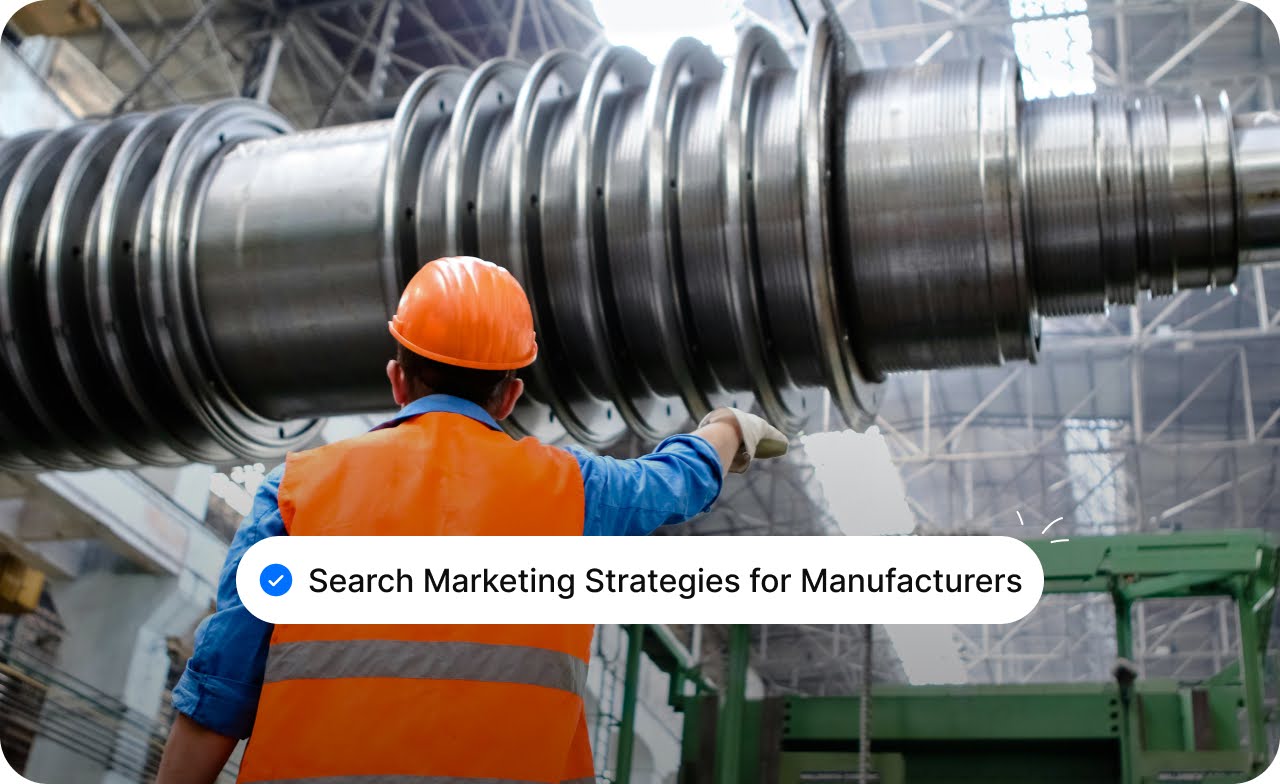
Manufacturers are wasting valuable resources on search marketing campaigns (strategies that drive traffic through paid ads and organic search results) that attract leads who don’t understand the complexities of your products or aren’t ready to buy.

Despite investing in SEO and PPC, the quality of leads often doesn’t justify the effort, leaving engineers, procurement teams, and plant managers overwhelmed with irrelevant inquiries.
The real challenge is attracting the right traffic.
This guide helps you target decision-makers who will understand your product's technical details and convert into loyal customers.
Manufacturers face unique challenges when it comes to search marketing.
Unlike consumer-facing industries, where people typically make quick, emotional decisions, manufacturing buyers, including engineers, procurement managers, and plant supervisors, have specific, technical needs that demand detailed information..
They search with a clear purpose: to find solutions that meet precise specifications, ensure compliance, and match complex project requirements.
This search behavior significantly impacts how manufacturers should approach their digital marketing strategies.

Here’s how search behavior differs across industries:
To effectively reach technical buyers, your keyword strategy must go beyond broad terms. It needs to align with the detailed, problem-solving searches that engineers, procurement managers, and decision-makers use.
These buyers are looking for very specific information, part numbers, technical specifications, and compliance standards.
Here’s how you can build a keyword strategy that matches their search intent and drives qualified leads. Key areas to focus on:
Buyers often search using specific part numbers or SKUs, especially when they already know what they need. Optimizing for these terms ensures your products show up in the right searches.
Compliance is critical in manufacturing. Ensure your content is optimized for industry standards (e.g., ISO, ASTM) and compliance-related terms to capture buyers looking for certified, compliant products.
Technical buyers often search for products based on specific processes (e.g., injection molding), materials (e.g., aluminum), tolerances, or finishes. Make sure your product pages include these technical details.
Each industry has its own language. Automotive, aerospace, and construction industries all require application-specific keywords that resonate with your audience’s needs (e.g., "automotive CNC machining" or "medical-grade plastic molding").
Creating content for engineers, procurement managers, and other technical decision-makers requires a clear, focused approach. These buyers don’t want oversimplified content; they need in-depth, technical information that addresses their specific challenges and concerns.
To capture their attention and drive conversions, your content must demonstrate technical expertise while being easily accessible and practical.
Here’s how to build content that resonates with this audience. Content pillars you should focus on:
Engineers often search for detailed product specifications or CAD files. Creating a centralized hub for downloadable specs and CAD files ensures you’re providing the technical data they need to make decisions.
Go beyond product features and explain the processes that make your solutions work. Provide quality assurance stories or discuss potential failure modes to show how your products address real-world challenges.
Compliance is crucial in many industries. Content that explains how your products meet industry standards (e.g., ISO, ASTM) builds trust with decision-makers who prioritize regulatory adherence.
Offer tools that engineers can interact with, like calculators for custom specs or configurators that help them tailor products to their needs. Demonstration videos showing the real-world applications of your products are invaluable.
Engineers value data-driven content. Case studies showcasing how your solutions have solved real problems for other clients, with clear metrics and outcomes, validate your expertise and reinforce your brand’s credibility.
Also Read: 25+ Proven Strategies to Transform Your Industrial Content Marketing
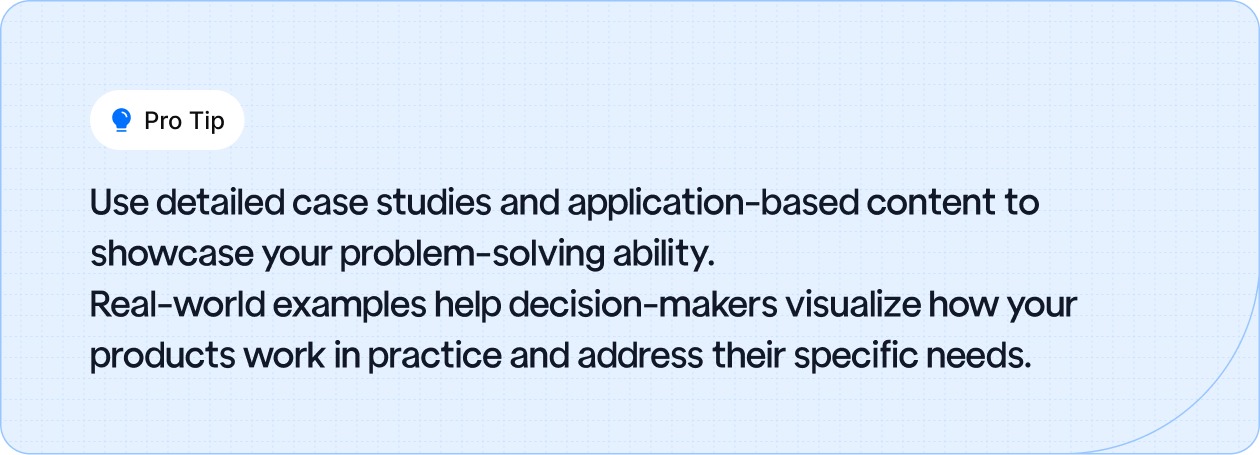
Technical SEO is crucial for ensuring that your website's detailed content, like CAD files, technical PDFs, and product specs, gets discovered by search engines.
Manufacturers often overlook key technical aspects that can make a significant difference in search visibility.
Must Read: 113 Distributors, Contractors & Architects Found Paniflex, Without a New Sales Hire
To succeed with PPC in manufacturing, campaigns must target the right decision-makers like engineers and procurement managers.
Here’s how to create campaigns that attract high-quality leads. Key PPC strategies for manufacturers:
Focus your campaigns on high-intent keywords, such as specific part numbers or industry certifications. These terms are used by buyers who are already familiar with what they need and are closer to making a purchase decision.
Use negative keywords to prevent your ads from showing up in irrelevant searches. For example, exclude terms like "cheap" or "free" to avoid wasting ad spend on consumers who aren’t looking to buy high-value industrial products.
Tailor your ad copy to highlight what matters most to technical buyers, certifications (e.g., ISO), lead times, and product capabilities.
These factors are often deal-breakers for engineers and procurement teams, so make sure your ads emphasize them.
Connect your PPC campaigns with your CRM and quoting workflows to track the performance of each lead.
By measuring the journey from ad click to quote request, you can optimize your campaigns for higher-quality leads and better ROI.
It’s important to measure lead quality and profitability. Look at how well your PPC leads convert into actual sales and factor in your product margins to determine the real value of each lead.

This will help you measure the true return on your PPC investment.
Optimizing lead capture forms is key to improving conversion rates in manufacturing. By making forms intuitive and mobile-friendly, you ensure that prospects can easily submit the information needed to generate accurate quotes.
Using AI-based prequalification tools can also help streamline the process, ensuring that only qualified leads reach your sales team.
Key strategies to improve conversion rates:

Account-Based Marketing (ABM) is an effective strategy for targeting specific buyer committees in the manufacturing industry.
By focusing your efforts on high-value accounts and using personalized outreach, you can build stronger relationships with engineers, procurement managers, and decision-makers.
This approach combines SEO and remarketing tactics to keep your brand top of mind and increase the likelihood of conversions.
Focus on the companies and roles that are most likely to convert. Identify your high-value target accounts, then zero in on the decision-makers within those organizations.
Leverage LinkedIn’s advanced targeting features and databases like ThomasNet to reach the right people. These platforms allow you to directly connect with engineers and procurement teams within your ideal accounts.
Create ads that promote your expertise. Share industry insights, whitepapers, and technical content that position your brand as a trusted leader in your field.
Develop tailored content sequences for each account. Use targeted emails, case studies, and product demos to engage prospects and guide them through the decision-making process.
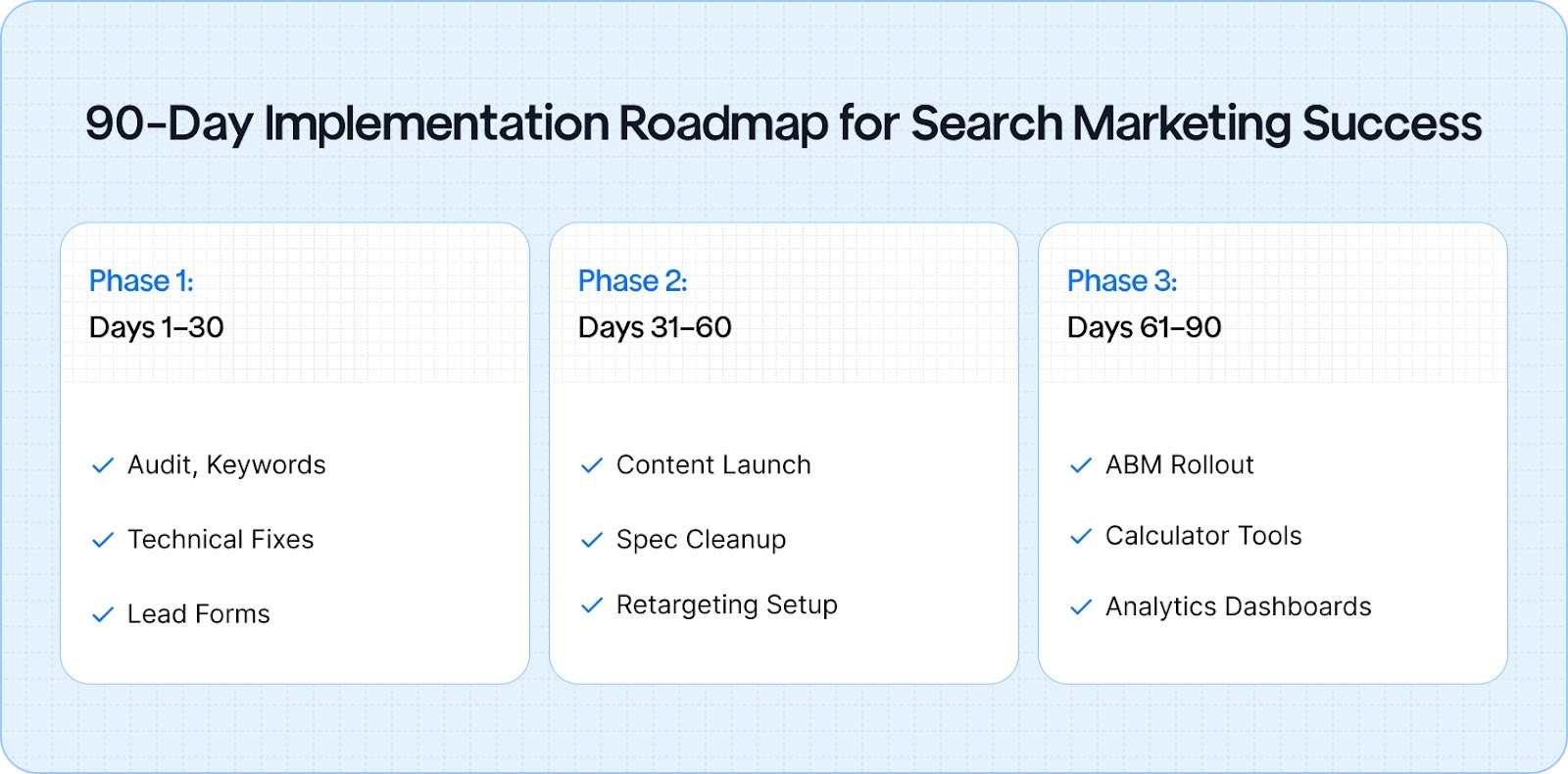
A successful search marketing strategy for manufacturers requires a clear plan and focused execution.
This 90-day roadmap will guide you through three actionable phases to optimize your online presence, attract qualified leads, and drive sales.
Manufacturers face unique challenges in search marketing, targeting the right decision-makers and driving quality leads that convert.
It's clear that a one-size-fits-all approach isn’t enough to achieve meaningful results. To truly optimize your search marketing, you need a tailored solution that streamlines your processes and boosts your ROI.
Key Takeaways:
A1: Manufacturers can enhance their search engine rankings by implementing robust Search Engine Optimization (SEO) strategies. This includes optimizing website content with relevant keywords, ensuring mobile-friendliness, improving site speed, and obtaining quality backlinks.
Additionally, creating detailed product specifications and case studies can attract technical buyers and improve organic visibility.
A2: SEO (Search Engine Optimization) focuses on optimizing your website to rank higher in organic (non-paid) search results, which builds long-term visibility. PPC (Pay-Per-Click) advertising, such as Google Ads, involves paying for ad placements in search results, providing immediate visibility.
Manufacturers often use a combination of both to balance short-term lead generation with long-term organic growth.
A3: To effectively reach engineers and procurement managers, manufacturers should focus on creating content that addresses their specific needs and challenges. This includes publishing technical blogs, whitepapers, and case studies that highlight product specifications and industry compliance.
Utilizing LinkedIn for targeted advertising and participating in industry-specific forums can also help in reaching these decision-makers.
A4: For B2B advertising in manufacturing, platforms like LinkedIn and Google Ads are highly effective. LinkedIn allows for precise targeting based on job titles and industries, making it ideal for reaching professionals such as engineers and procurement managers.
Google Ads can capture intent-driven searches, directing potential leads to your website.
A5: Measuring the return on investment (ROI) of digital marketing efforts involves tracking key performance indicators (KPIs) such as website traffic, lead conversions, and sales attributed to marketing activities.
Tools like Google Analytics and CRM systems can help in monitoring these metrics. It's important to align marketing goals with business objectives to accurately assess ROI.
A6: Content marketing plays a crucial role in manufacturing marketing by educating potential customers and establishing authority in the industry.
Creating valuable content, such as technical guides, product demonstrations, and customer testimonials, can attract and engage your target audience. This approach aids in SEO and builds trust with potential clients.
A7: Hiring a digital marketing agency can be beneficial for manufacturing businesses, especially if internal resources are limited. An experienced agency can provide expertise in SEO, PPC, content creation, and analytics, helping to develop and execute a comprehensive digital marketing strategy tailored to your business needs.
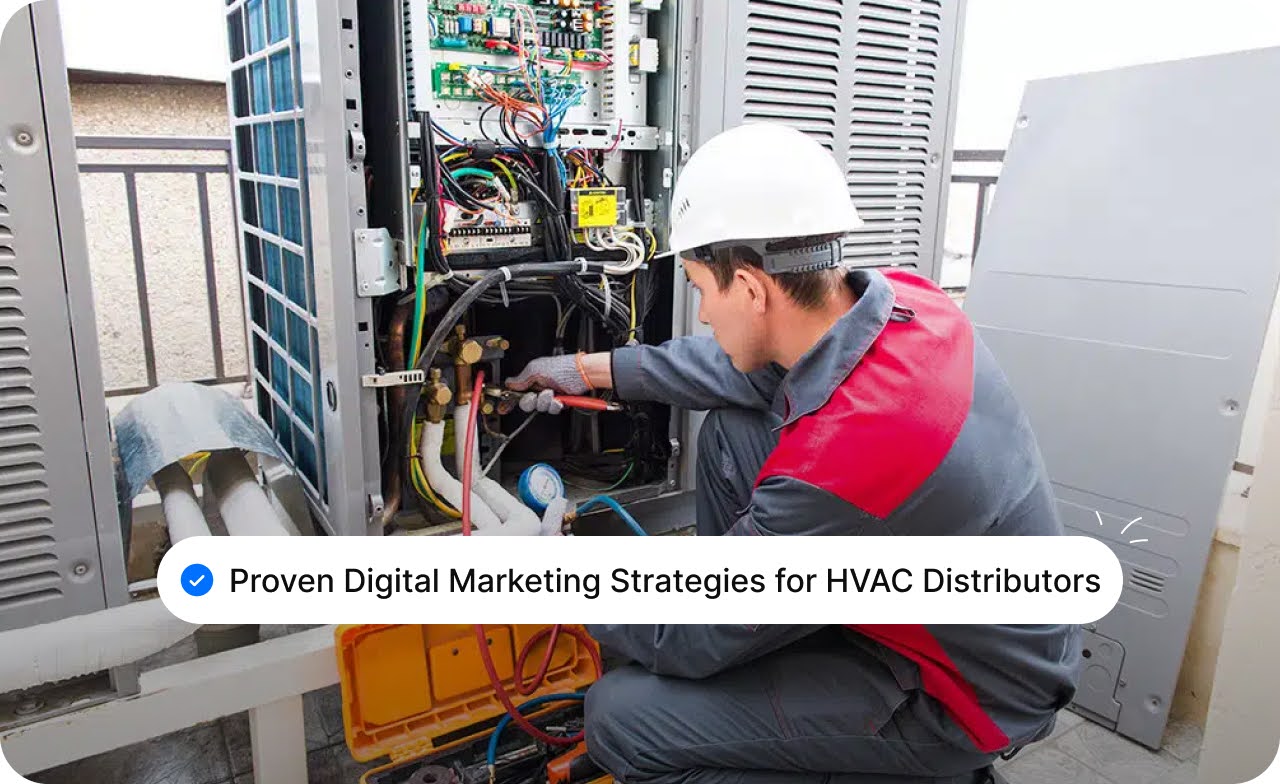
HVAC distributors often face a unique challenge: their digital marketing efforts generate plenty of traffic but fail to convert that traffic into qualified leads.

While big competitors flood the market with generic ads and broad campaigns, smaller distributors struggle to stand out and reach the right customers.
In a crowded digital space, the real challenge lies in targeting and engaging the right audience, one that values your products and services.
This article will break down proven strategies for HVAC distributors to cut through the noise, optimize their online presence, and drive more meaningful, revenue-generating interactions with the customers who matter most.
A strong online presence is essential for reaching the right customers. Digital marketing provides HVAC distributors with the tools to target, engage, and convert prospects more efficiently than traditional methods.
With more consumers turning to the internet for HVAC needs, your visibility online directly impacts your business success.
91% of homeowners rely on online reviews before picking contractors, meaning HVAC distributors who aren’t visible in search results are missing out on key opportunities.
Digital marketing allows HVAC distributors to stand out in a crowded market by reaching the right audience with tailored messages.
Using platforms like SEO, social media, and targeted ads, you can highlight your unique offerings and position your brand as the go-to expert in the industry.
Compared to traditional advertising, digital marketing allows HVAC distributors to maximize their budgets with highly targeted campaigns.
Tools like Google Ads and SEO enable precise audience targeting, which means you can track performance, optimize strategies, and ultimately get a better return on investment.
To stand out in the crowded HVAC market, implementing the right digital marketing strategies is crucial.
These approaches drive traffic and help you convert visitors into long-term customers. Here are the most effective strategies for HVAC distributors.
SEO is essential for driving organic traffic to your website, ensuring that your business is visible to potential customers who are actively searching for HVAC products and services.
How to Do It: Start with keyword research to identify high-value terms related to HVAC parts and services. Optimize your website with proper on-page SEO techniques, use targeted headings, meta tags, and internal links.
Create dedicated landing pages for each service or product category to improve search engine rankings.
![Optimize your website for geo-targeted keywords like 'HVAC parts in [city]' to improve local SEO and appear in relevant local searches.](https://cdn.prod.website-files.com/6614dca1d3aa7b076d6f3004/68ff6fef88835c5190c30626_9699e023.jpeg)
PPC is an effective way to generate immediate results by targeting users actively searching for HVAC-related products. It helps you get in front of potential customers quickly and drives traffic to your website.
How to Do It: Set up Google Ads campaigns focusing on high-intent keywords like “HVAC parts distributor” or “commercial HVAC equipment.”
Optimize your ads for conversions by linking to well-designed landing pages with clear calls to action.
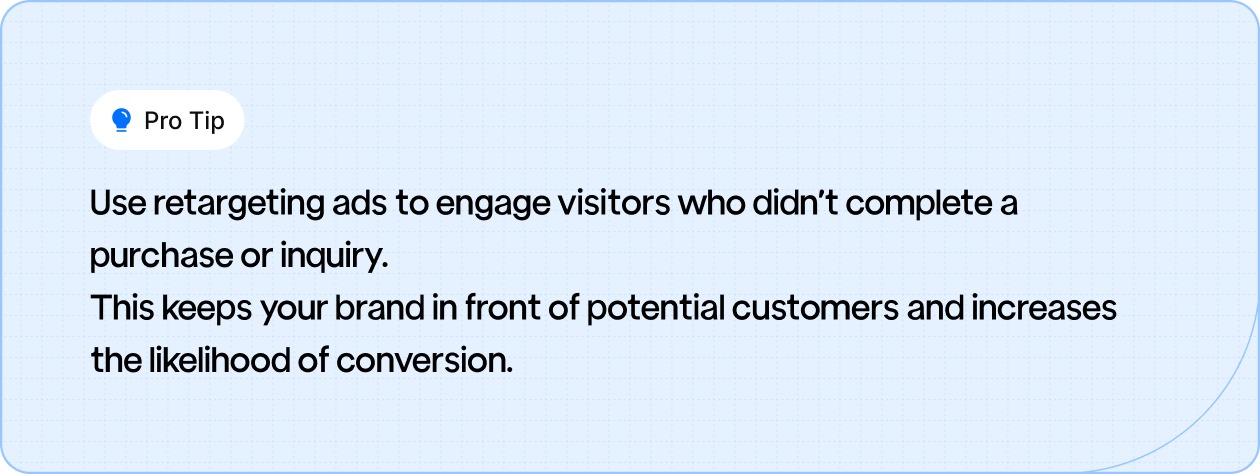
Social media is a powerful tool for building brand awareness and engaging with your audience.
Platforms like Facebook, Instagram, LinkedIn, and Twitter offer opportunities to connect with both B2B and B2C customers.
How to Do It: Share helpful product tips, industry news, and customer success stories on your social channels. You can also run ads to reach a broader audience and promote special offers or new products.
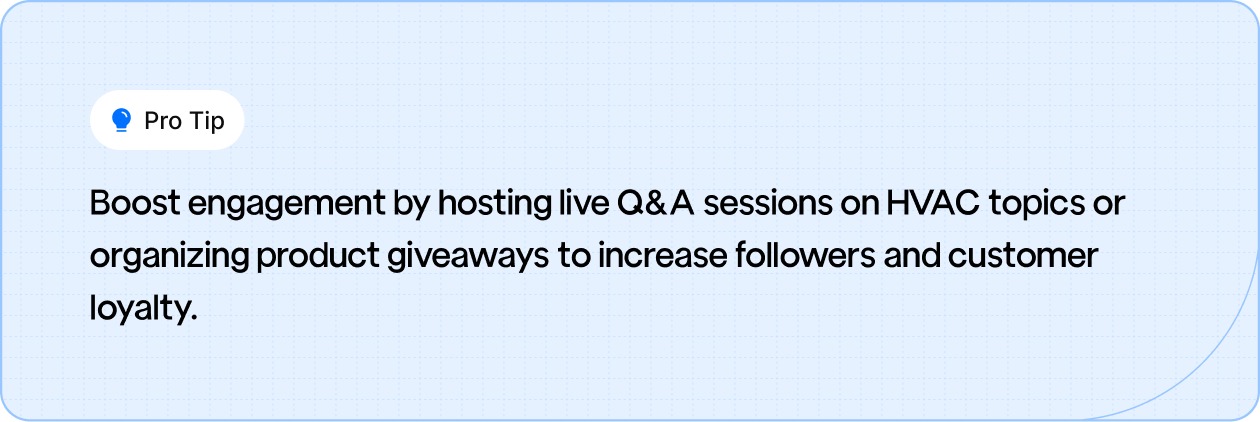
Email marketing provides a direct line to your leads and customers.
With a 90% open rate for well-crafted emails, it’s a powerful tool for nurturing relationships and encouraging repeat business.
How to Do It: Use email campaigns to announce new products, share HVAC maintenance tips, or offer seasonal promotions. Segment your email list to deliver personalized content to the right audience, including first-time visitors and loyal customers.
Must Read: Top 10 Lead-Focused Content Marketing Services for HVAC Manufacturers

The HVAC distribution market is competitive, and many manufacturers face similar challenges when it comes to digital marketing.
From building brand recognition to generating qualified leads, these hurdles can be overwhelming, but they are entirely surmountable with the right strategies in place.
Problem: Many HVAC distributors struggle to make their brand stand out in a saturated market, which can lead to missed opportunities with potential customers.
Solution: To build strong brand recognition, focus on creating a consistent online presence using content marketing, SEO, and social media platforms.
These tools help elevate your brand and make it visible to those actively searching for your products or services.
In a discussion on Reddit, a commercial HVAC professional emphasized the value of focusing on niche services to differentiate from competitors.
By creating detailed content that addresses specific customer needs and utilizing digital channels for distribution, HVAC distributors can build brand authority and attract a targeted audience.

Problem: Even with increased traffic, many HVAC distributors struggle to convert website visitors into actual leads, which impacts their sales pipeline.
Solution: Improve your lead generation efforts by optimizing your website with clear CTAs (Call-to-Actions), well-designed landing pages, and effective lead magnets such as downloadable guides or product catalogs.
These elements guide prospects towards taking action and filling out contact forms.
Problem: Smaller HVAC distributors often find it difficult to compete with large, well-established companies that have bigger marketing budgets and teams.
Solution: To level the playing field, focus on a niche approach. Highlight personalized service and local expertise that larger competitors may overlook.
This allows you to create a unique selling proposition (USP) that resonates with specific customer needs.
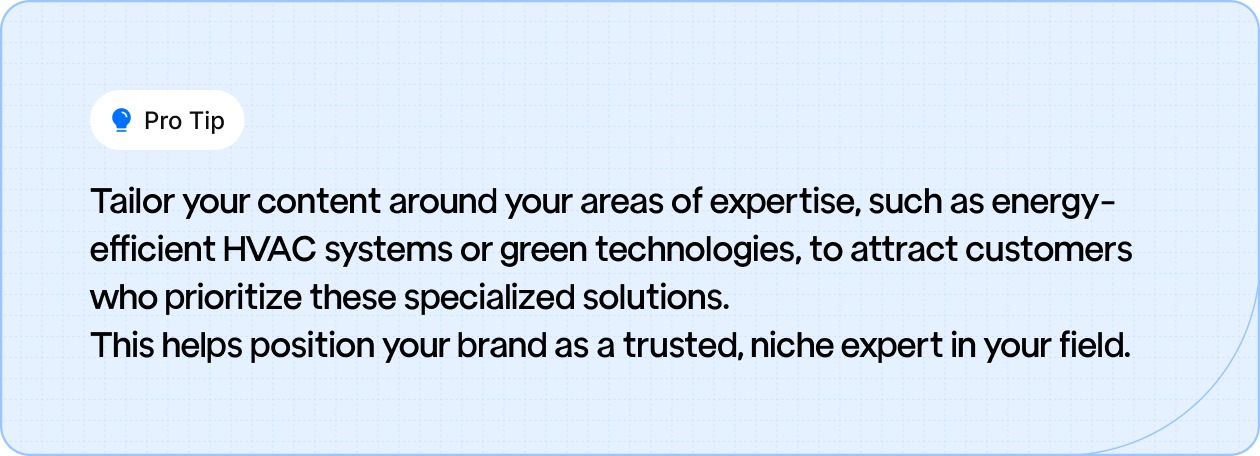
Key Metrics:
Key Tools:
Choosing the right digital marketing platform is crucial for HVAC distributors looking to grow their online presence and generate qualified leads. With so many agencies out there, it can be overwhelming to find the right fit.
Here's how to make an informed decision that ensures your marketing efforts are in good hands.
Digital marketing for HVAC distributors requires specialized knowledge and constant optimization. Running campaigns across SEO, PPC, social media, and email marketing can quickly become overwhelming without the right expertise.
A renowned and trusted platform allows you to tap into their experience and resources, saving you both time and money while focusing on running your business.
Gushwork has a proven track record in helping businesses optimize their digital marketing strategies, boosting their visibility and lead generation.
By asking these key questions, you'll gain a better understanding of how the platform works and how it can meet your unique needs. Choosing the right digital marketing platform can save you time, reduce marketing costs, and help you achieve faster growth in the highly competitive HVAC market.
Platforms like Gushwork offer trusted expertise and proven strategies to accelerate your success, so you can focus on what matters most: your business.
To remain competitive and drive sustainable revenue, HVAC distributors must embrace modern digital marketing strategies. Relying on traditional marketing methods simply won’t deliver the same results in today’s fast-paced, online-driven market.
By adopting SEO, PPC, and social media marketing, distributors can effectively reach the right customers, improve brand visibility, and establish themselves as trusted industry leaders.
Taking action now is crucial. Whether you're optimizing your website for better search rankings, launching a targeted ad campaign, or engaging on social platforms, each step contributes to your growth.
By focusing on the right digital strategies, HVAC distributors can achieve lasting success and stand out in a crowded marketplace.
A1. HVAC distributors can increase online visibility by focusing on local SEO, optimizing their website for search engines, creating valuable content, and maintaining an active social media presence. Ensuring your business appears in local search results is crucial for attracting customers in your service area.
A2. A combination of SEO, PPC advertising, and social media marketing is the best approach. SEO helps you rank higher in search results, PPC drives immediate traffic, and social media engages customers directly. Tailoring your strategy to your specific audience is key to success.
A3. Social media marketing helps HVAC distributors build brand awareness, engage with local communities, and share educational content. Platforms like Facebook, Instagram, and LinkedIn allow distributors to connect directly with potential customers, showcase their expertise, and promote special offers.
A4. Key metrics include conversion rate, customer acquisition cost (CAC), return on ad spend (ROAS), bounce rate, and time on page. Tracking these metrics helps you assess the effectiveness of your campaigns and make data-driven decisions to optimize your marketing efforts.
A5. Local SEO is crucial for HVAC distributors since most customers search for services within a specific geographic area. Optimizing for local search helps your business appear in local search results, especially on platforms like Google My Business, which increases visibility and drives more relevant leads.
A6. Yes, investing in PPC advertising can provide immediate results and help HVAC distributors generate leads quickly. Targeted PPC campaigns focusing on high-intent keywords like “HVAC parts” or “emergency AC repair” can drive qualified traffic and complement long-term SEO efforts.
A7. HVAC distributors can generate more leads by optimizing their website with clear calls-to-action (CTAs), easy navigation, and dedicated landing pages for specific services or products. Offering downloadable resources like maintenance guides or product catalogs in exchange for contact information is another effective strategy.





.svg)
.svg)
.svg)